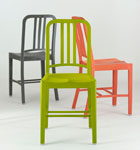
Gregg Buchbinder, CEO of Emeco
The cast of characters: Emeco is a Pennsylvania-based furniture-maker famous for its über-hip chairs handmade out of recycled aluminum. Coca-Cola is an iconic soft-drink company known for its animated polar bears and its environmental efforts to protect real bears’ habitat.
How did the two meet? “Coca-Cola came to Emeco in 2006 and asked if we could use their recycled PET [recycled polyethylene terephthalate, rPET for short] bottles to make a chair, bottles that otherwise would remain in the landfill,” explains Emeco CEO Gregg Buchbinder. “At Emeco we have always been working towards zero waste and decided to help Coca-Cola to find a solution.”
That solution was the 111 Navy Chair, an rPET riff on Emeco’s regular Navy chair. Since its debut in 2010, the seat has kept six million bottles out of landfills.
Pros (+)
+ Using rPET helps keep millions of plastic bottles out of landfills each year
+ Pioneering fabrication techniques will help innovate less costly ways to work with recycled material
+ The 111 Navy Chair can help inspire others to make wise environmental decisions
+ rPET helps combat the “everything-is-disposable” mindset
Inspiration.
The design of the 111 Navy Chair—named for the 111 bottles required to make it—was an inspiration in itself. “We didn’t want to do something that was about the design per se,” Buchbinder says. “It was about the material and being able to really figure out the science of the material and utilize it, rather than have people focus on the shape and style.” So Emeco just replicated its original Navy Chair design, transforming it not via new lines and contours but via its new material properties.
Preparation.
It was a simple idea—but not an easy one, Buchbinder says. The first step was determining whether it was even possible to make the rPET strong enough for use in a high-use application like a chair. The tolerances of the material are narrow compared to virgin plastic. It’s difficult to work with, it’s expensive, and the tooling is more elaborate because the melting point is much higher.
What makes the original, aluminum chair so strong is that there are no fasteners—it’s made as one solid piece. So Emeco decided to make this chair the same way. But to mold a complicated shape like this takes a lot of engineering and time. “It’s not your typical Ikea pop-it-out plastic chair,” Buchbinder says.
Cons (–)
– Recycled material is still technically more expensive than virgin material
– rPET is more difficult to mold than virgin material
– rPET has tighter tolerances, making the margin of error narrower
– The molding time for rPET is longer
Composition.
Emeco and BASF scientists developed a composite mix made of 65 percent rPET and 35 percent pigmentation and glass fiber (the latter to add to the chair’s strength). In the end, the chair was strong enough that Emeco felt perfectly comfortable offering customers a five-year structural warranty. Plus, the “velvet” finish is scratch resistant and complies with California and UK fire codes.
Coloration.
Emeco worked with color expert Laura Guido-Clark to establish an earthy array of colors. Originally, Emeco wanted to be sure people understood that it was derived from recycled material. Some suggested a confetti look where one could see parts of the plastic. “[Guido-Clark] said, ‘You know, the intelligence is really baked into this chair,’” Buchbinder recalls. “The desire was to have a color and a finish and a texture that really made the chair look beautiful, as opposed to recycled. Accomplishing that wasn’t so easy.”
Emeco was adamant that toxins not be part of the chair’s configuration, a difficult stipulation since most pigments contain chromium, which breaks down plastic—especially red. But Coca-Cola’s iconic color wasn’t off the table for long. The scientists at BASF helped develop pigments that were nontoxic, including red. “It actually has performed better than any other color in the testing,” Buchbinder says of the color. “We not only have done it in a nontoxic way, we have made a superior pigment to what is currently on the market.” The final palette: Red, Snow, Flint Gray, Grass Green, Persimmon, and Charcoal.


